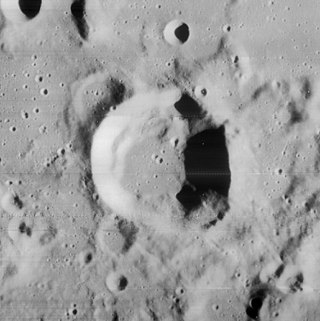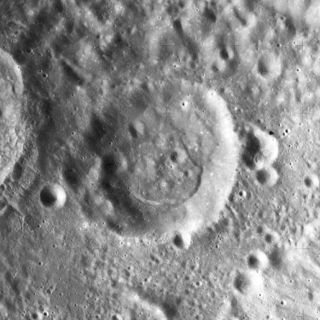
Bianchini is a lunar impact crater that lies along the northern Jura Mountains that ring the Sinus Iridum, in the northwestern part of the near side of the Moon. It was named after Italian astronomer Francesco Bianchini. The impact of this crater near the edge of the Jura Mountains deposited some material into the Sinus Iridum floor.

Behaim is a lunar impact crater that is located near the eastern limb of the Moon, just to the south of the crater Ansgarius. To the south of Behaim is the crater Hecataeus, and to the east-southeast is Gibbs.

Bridgman is a lunar impact crater that is located on the far side of the Moon. It lies in the northern hemisphere, to the northwest of the crater Kurchatov. To the west-southwest is the old formation Becquerel, and eastward are the craters Pawsey and Wiener.

Ellison is a lunar impact crater that lies on the far side of the Moon from the Earth. It is located just beyond the northwest limb of the Moon, to the southwest of the large walled plain Poczobutt. Due west of Ellison is the crater Coulomb.

Schomberger is a prominent lunar impact crater that lies in the southern part of the Moon, in the area near the limb. It is located to the southwest of the crater Boguslawsky, and southeast of Simpelius. The relatively young satellite crater Schomberger A is nearly attached to the southern rim, and the much-aged Schomberger C lies just off the western rim.

Carpenter is a lunar impact crater in the northern part of the Moon, relatively close to the limb. At this position the crater is foreshortened and appears oval in shape. It is, however, very nearly circular in outline. The outer rampart to the south is adjoined to the old crater Anaximander, and the satellite formation Anaximander B lies along the western rim. To the northeast is Anaximenes.

Philolaus is a lunar impact crater that is located in the northern part of the Moon's near side. It lies within one crater diameter to the east-southeast of the flooded crater Anaximenes, and to the west of the smaller Anaxagoras. It overlies the older and heavily worn Philolaus C to the south.

Moiseev is a lunar impact crater that is located just on the far side of the Moon. It lies to the south-southwest of the slightly larger crater Hertz, and north of Saenger. To the southeast lies the irregular crater Al-Khwarizmi.

De Forest is a lunar impact crater on the far side of the Moon. It is located in the far southern hemisphere, to the west of the large walled plain Zeeman and due south of the crater Numerov. Because of its proximity to the southern pole, this crater receives sunlight at an oblique angle when it is on the illuminated half of the Moon.

Cori is a lunar impact crater that is located in the southern hemisphere on the far side of the Moon. It lies less than one crater diameter to the north of the crater Baldet. To the northeast is the crater Grissom. It is named after Gerty Cori, the first American woman to win the Nobel Prize and the first woman to win the prize in the category Nobel Prize in Physiology or Medicine.

Dryden is a lunar impact crater that is located on the southern hemisphere on the far side of the Moon. It lies within the huge walled plain called Apollo, and is one of several features within that basin named after people associated with the Apollo program. Apollo itself has an inner ring, and Dryden is attached to the west-northwest part of that circular mountain formation. To the south of Dryden along the same range is the crater Chaffee.

d'Alembert is a large lunar impact crater located in the northern hemisphere on the far side of the Moon, to the northeast of the somewhat smaller walled plain Campbell. Astride the southwest rim of d'Alembert is Slipher. To the north is the crater Yamamoto, and to the south-southwest lies Langevin. This walled plain has the same diameter as Clavius on the near side, making it one of the largest such formations on the Moon.

Lyman is a lunar impact crater that lies in the southern hemisphere on the far side of the Moon. It is located to the south of the huge walled plain Poincaré, and to the northeast of Schrödinger, another walled plain. To the east-southeast is the larger crater Minnaert.

Drebbel is a small lunar impact crater named after Cornelius Drebbel that is located to the northeast of the large walled plain Schickard, in the southwestern part of the Moon. Further to the northeast is the Lacus Excellentiae and the small crater Clausius.

Chauvenet is a lunar impact crater that is located to the northeast of the prominent crater Tsiolkovskiy on the far side of the Moon. Less than one crater diameter to the northwest of Chauvenet is the crater Ten Bruggencate.

Fourier is a lunar impact crater that is located in the southwestern part of the Moon's near side, just to the southeast of the crater Vieta. To the northeast is the Mare Humorum. The rim of this crater is roughly circular, but appears oval when viewed from the Earth due to foreshortening.

Spallanzani is a lunar impact crater located in the rugged, crater-marked terrain of the Moon's southern hemisphere. It was named after Italian natural scientist and biologist Lazzaro Spallanzani. To the southeast is the prominent crater Pitiscus, and to the north is Nicolai.

Ideler is a small lunar impact crater in the low southern latitudes of the Moon. This formation is visible from the Earth, but it appears somewhat foreshortened due to its location. The crater lies just to the northeast of the larger crater Baco, and west-northwest of the prominent Pitiscus. To the west-northwest of Ideler is Breislak.

Finsen is a lunar impact crater that is located in the southern hemisphere, on the Moon's far side. It is attached to the southeastern exterior of the walled plain Leibnitz, and the ejecta from Finsen covers the southeastern part of Leibnitz's interior floor. To the southwest of Finsen is another walled plain, Von Kármán, partly overlain by Leibnitz.

Litke is a lunar impact crater that lies within the large walled plain Fermi, near the north-northwestern inner rim. Less than one crater diameter to the west-northwest is the slightly larger Delporte. Litke is located on the far side of the Moon and cannot be viewed directly from the Earth.





















